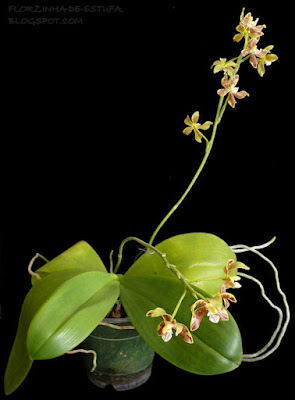Phalaenopsis viridis is native to Sumatra. These orchids grow at 792 m, usually on limestone rocks or low on tree branches in dark corners, sometimes close to Phalaenopsis fimbriata. However, unlike Phalaenopsis fimbriata, it quickly dies at higher altitudes, but grows well at lower altitudes, in warmer conditions.
Phalaenopsis viridis orchid, also called as The Green Phalaenopsis, Phalaenopsis forbesii, Polychilos viridis, is a species of the genus Phalaenopsis. This species was described by Johannes Jacobus Smith in 1907.
IDENTIFY PHALAENOPSIS VIRIDIS ORCHID
Phalaenopsis viridis is native to Sumatra. These orchids grow at 792 m, usually on limestone rocks or low on tree branches in dark corners, sometimes close to Phalaenopsis fimbriata. However, unlike Phalaenopsis fimbriata, it quickly dies at higher altitudes, but grows well at lower altitudes, in warmer conditions.
It is a small sized, warm growing epiphyte with a very short stem carrying a few, oblong-obovate, narrowing towards the base, basally clasping leaves. The leaves are 30 cm long, they are oval, flat, shiny and slightly leathery.
The Green Phalaenopsis blooms spring on an erect to horizontal, simple or occasionally branching, to 16" (40 cm) long, few to several flowered inflorescence with ovate acute floral bracts and carrying a flush of simultaneously opening, fleshy flowers. The flowers are 4 cm in diameter, they are fleshy, spread and have a starry shape. The petals of both whorls have slightly curved edges, greenish-yellow color and are marked with reddish-brown spots. The lip and spine are white with purple stripes and the protuberance is yellow.
PHALAENOPSIS VIRIDIS ORCHID CARE AND CULTURE
Cultural information should only be used as a guide, and should be to be adapted to suit you. Your physical location; where you grow your plants, how much time you have to devote to their care, and many other factors, will need to be taken into account. Only then can you decide on the cultural methods that best suit you and your plants.
Light:
Phalaenopsis viridis needs a light level of 8000-10000 lux and prefer shade.
Temperature:
The average temperature of the summer day is 29 ° C, the night 19-21 ° C, and the daily difference is 9 ° C. The average temperature of the winter day is 27-29 ° C, the night 19-20 ° C, and the daily difference is 7-9 ° C.
Humidity:
This species needs an air humidity level of 75-80%.
Substrate, growing media and repotting:
The substrate must be a mixture of 12-16 mm bark or sphagnum with the addition of perlite or charcoal. Small pieces of limestone can be added to the substrate provided that hot water is used for watering. Repotting can be done at any time when growth is evident.
Watering:
Phalaenopsis viridis should be constantly moist throughout the year. Watering with warm water is recommended. The precipitation pattern is wet / wetter.
Fertilizer:
It is recommended that 1/4-1/2 doses of fertilizer for orchids applied every week or every 2 weeks in the growing season.
Rest period:
For a period of about 3 months in winter, the level of light is higher, the humidity should be high and plants should be moist throughout the year.
If there are problems with flowering, plants should be subjected to sudden cooling during the day by approximately 5.6 ° C, which can be related to the decrease of temperature associated with cool summer rains or spraying in the greenhouse. Temperature drops are more significant during warm weather, when the humidity is lower and the cooling effect associated with rapid evaporation is greatest.















COMMENTS